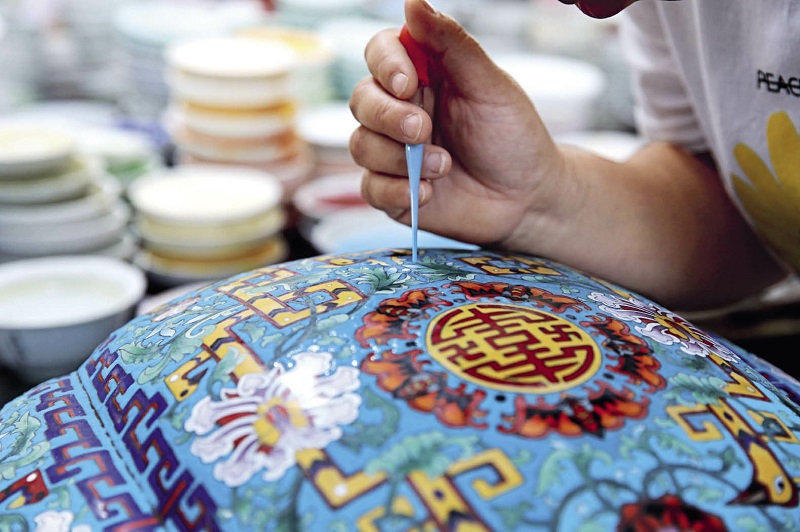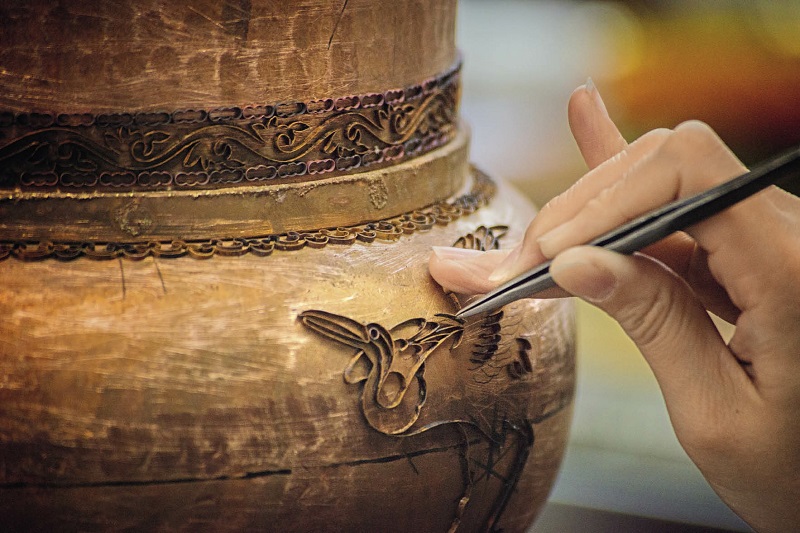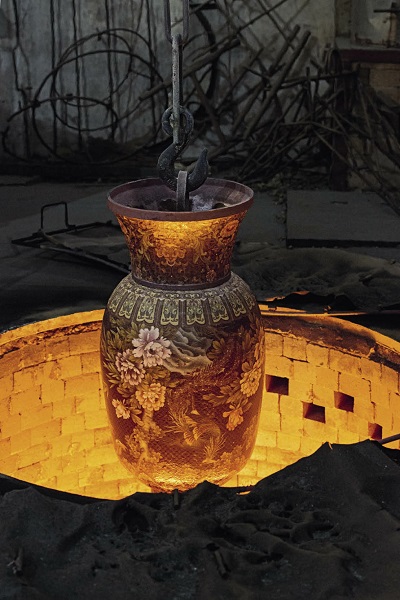Legend has it that in the 13th century, Kublai Khan (1215-1294), who established the Yuan Dynasty (1279-1368), discovered an exquisite kind of handicraft when fighting around Arabia in the Eurasian continent. The war was brutal, but Kublai Khan was so impressed with the craft he found that he spared the lives of the craftsmen and took them back to China. These skilled individuals were then ordered to make the exquisite handicrafts for Mongolian nobles. What they made was cloisonné, an ancient metalworking technique.
China’s cloisonné art is a combination of the introduced techniques from that time and local metal enamel crafts. The introduced cloisonné techniques first appeared in ancient Greece. From the fourth to the sixth centuries, the craft spread to the Byzantium Empire, and became very popular in Europe. In the 11th and 12th centuries, it spread eastward to Persia (present-day Iran), and then to China during the Yuan Dynasty more than 700 years ago.
In the hands of Chinese cloisonné craftspeople, thin strips of metal, usually copper, are bent and curved to follow the outline of a decorative pattern. They are then attached, usually soldered, to the surface of bronzeware, forming miniature walls that meet and create little cellular spaces. Powdered enamel is used to fill the cellular spaces. The object is then fired, and after cooling, the surface can be polished to remove imperfections and add to the luster.
During Emperor Jingtai’s reign (1450–1457) in the Ming Dynasty (1368-1644), the dynasty following the Yuan, Chinese cloisonné reached a high level of craftsmanship. Because the enamelware made during his reign was typically blue, it was called “Jingtai Blue.”
“Jingtai Blue,” with its elegant shape and bright colors, still enjoys a good reputation in the world’s craft history. In China, it is regarded as the quintessence of Chinese culture.

Enamels are applied to the surface in their wet, powdered state.
Precious Handicraft
Different from Chinese antique porcelain objects collected by ordinary people, cloisonné enamelware originated in the royal court and was thus considered royal art. It was always exclusively made for the imperial family, never finding its way into the hands of the general public. Besides, the craft was dominated by the imperial court, especially in the Ming and Qing dynasties, when special production institutions were set up.
Since the beginning, Chinese cloisonné has incorporated China’s painting skills and elements of its traditional culture. It is the integration of a variety of crafts, including bronze smelting, forging and enamel crafts, as well as traditional painting and metal chiseling techniques.
China’s cloisonné craft is very complex. The most exquisite process includes soldering copper strips to the surface of the substrate. The craftsman needs to hold the flat copper strips with tweezers and solder them according to the designed pattern. This is a very demanding process as it needs to be done in one operation. Craftsmen should understand the image and structure of the design, such as a bird’s claws and eyes, in order to make it vivid. In the hands of a skilled craftsman, details of a blooming flower or an auspicious flying dragon can be done with ease.
Another demanding process is applying vitreous enamel paste to the surface of the object. The craftsman first mixes the paint according to the drawing, and then embellishes the object.
Cloisonné enamelware is completely handmade. Any small error could spoil a beautiful piece.

In the hands of an artisan, copper strips are bent and curved to follow the outline of a decorative pattern and then soldered to the surface of a roughcast bronze ware with tweezers.
Beijing Enamel Factory
Since the reign of Emperor Jingtai, China’s cloisonné had been considered royal luxury right up until the Qing Dynasty (1644-1911). Especially during the reign of Emperor Qianlong, when China’s national strength reached its zenith, the craft also reached another prime period of development.
After the demise of the Qing Dynasty, decades of war and social upheaval left people in poverty, and “Jingtai Blue” art was on the verge of extinction.
After the founding of new China in 1949, the government attached great importance to the protection of traditional crafts. Initiated by celebrities in the cultural circle, such as Guo Moruo, Shen Congwen, Liang Sicheng, and Lin Huiyin, a traditional arts and crafts rescuing team was set up in Tsinghua University. Qian Meihua, who was a young member of the team, later grew into a master of the technique. In 1956, Beijing Enamel Factory was established and Qian was the first chief artisan.
The cloisonné handicrafts produced by Beijing Enamel Factory were exported to foreign countries, which made a great contribution to China’s economic development. After the introduction of the reform and opening-up policy in 1978, cloisonné products were exported on a large scale for many years, and were known and loved by more and more Chinese people. In 2006, the “Jingtai Blue” craft was included on the first national intangible cultural heritage list.
Dedication to the Art
Zhong Liansheng is the current chief artisan and general manager of Beijing Enamel Factory. He is also a national inheritor of the “Jingtai Blue” art. He did an apprenticeship at the Beijing Enamel Factory in 1978 at the age of 15. After getting a solid foundation in art design, he studied the art of cloisonné. It has been 43 years since Zhong first walked through the door of Beijing Enamel Factory and began learning the craft of cloisonné.
During Zhong’s career, he was profoundly influenced by Qian Meihua.
“Qian was my teacher. She was very gentle and always spoke in a soft voice. Whenever she talked about her artistic experience and creation, there was always a smile on her face. She often reminisced about the days with Liang Sicheng and Lin Huiyin in Tsinghua University. The greatest influence Qian had on me was her dedication to art. From the time she entered the industry in her 20s, to the age of 83, her dedication, passion, and commitment always inspire me,” said Zhong.
Speaking of Qian’s works, Zhong was especially impressed by a cloisonné disk symbolizing peace.
“I still remember in 2004 when she was at home arranging her old manuscripts, and she gave me a sketch of a cloisonné disk. She told me that the next year was the 60th anniversary of the end of the world’s Anti-Fascist War, and she wanted to design a disk. It measures 60 centimeters in diameter, with patterns from Dunhunag murals to form several concentric circles. Small peonies represent prosperity, peace, and happiness, and some small evergreens symbolize the vitality of humankind. In the center of the disk is a dove of peace holding an olive branch. We helped her make the disk. It was very beautiful,” said Zhong.

A “Jingtai Blue” artwork is fired up in a kiln before it is finished.
Accessible to All
In the imperial palace of the Yuan, Ming, and Qing dynasties, cloisonné enamelware was used for display and decoration, or as sacrificial ornaments. Over the years, Zhong Liansheng and his apprentices continued to expand the application field of this craft. Based on inheritance and innovation, they brought this craft into people’s daily life.
The most influential design is the combination of wooden decorations and cloisonné craftsmanship in the Jixian Hall of Beijing Yanqi Lake International Convention & Exhibition Center, the main venue of the 2014 APEC summit. Inside the Jixian Hall, decoration on the 18 wooden pillars, many wall ornaments, and door handles are full of “Jingtai Blue” elements, which drew the attention of guests from home and abroad.
In addition, the Jingtai Station of Beijing’s Subway Line 14, which is near the Beijing Enamel Factory, is decorated with the lotus flower images, the most representative patterns in Emperor Jingtai’s reign in the Ming Dynasty. In addition, the whole process of craftsmen making cloisonné enamelware during Emperor Jingtai’s reign is also displayed on the walls of the station’s interior.
In Zhong’s opinion, the influence of cloisonné has gradually increased over the past decades as the country has continued to promote the art. High auction prices also added to its fame. Zhong believes that today “Jingtai Blue” has reached its most brilliant and mature stage in history. It has also entered ordinary Chinese people’s lives.
The sophistication of the art means that it becomes very difficult to innovate. Zhong has two expectations for the younger generation of artists: a good artistic foundation and great passion. “Now, the techniques have been almost made perfect, and even the sketch of a line is already flawless. To innovate is very difficult, but as long as you pay attention, life itself has a lot of things to offer.”